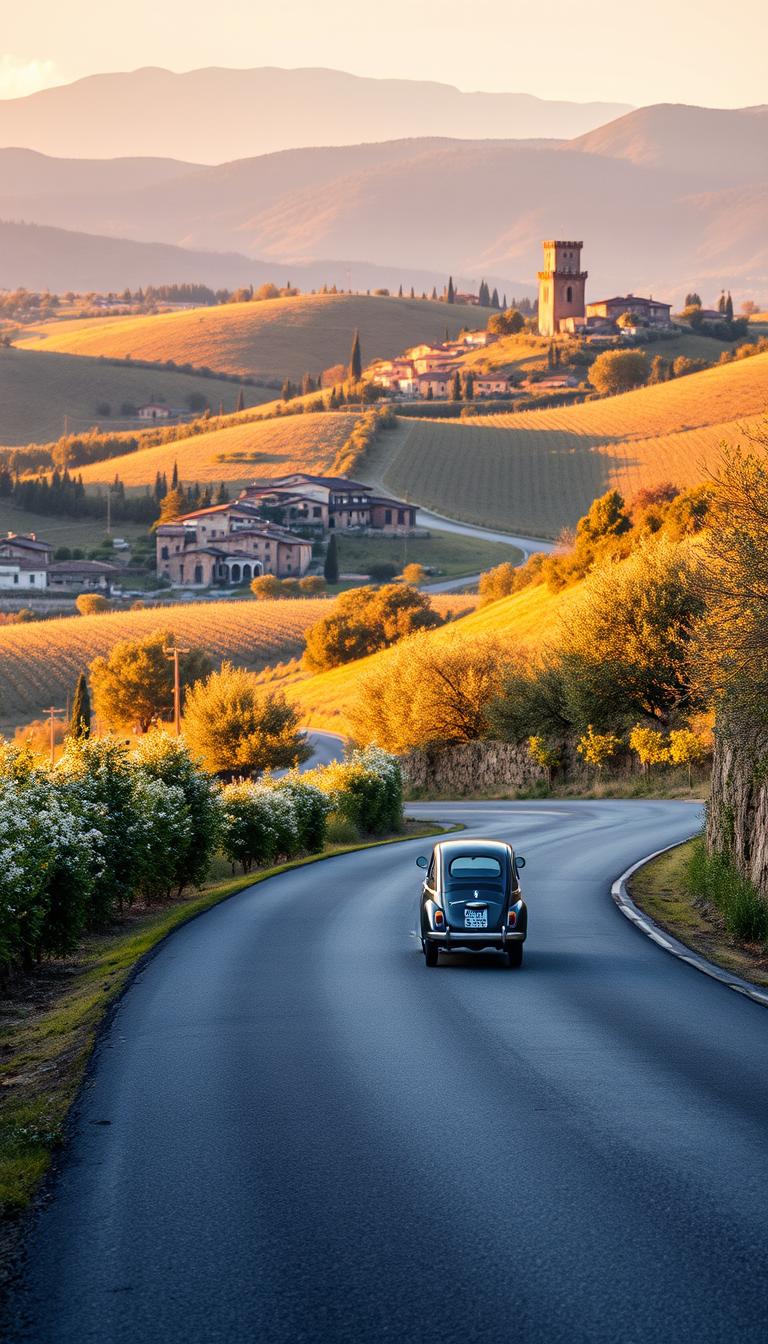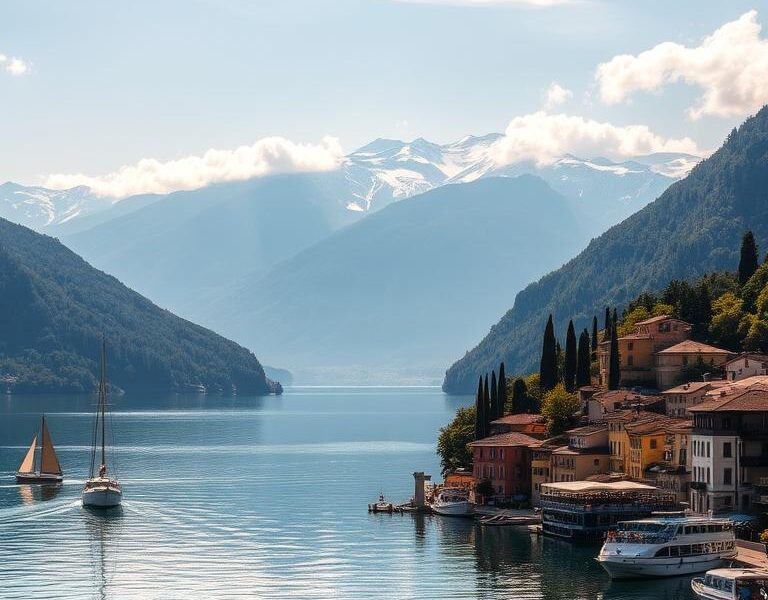Did you know 87% of Italy’s 65 million annual tourists never venture beyond Rome, Venice, or Florence? This road trip flips the script, guiding you through sun-drenched coastal highways and hilltop villages where la dolce vita feels refreshingly authentic.
Over 14 days, you’ll discover a carefully crafted blend of iconic landmarks and secret spots. Start in Genova’s labyrinthine alleyways before winding south to Southern Italy’s coastal villages. The journey balances flexibility with structure – perfect for travelers who crave spontaneity but appreciate local insights.
This post contains affiliate links. If you purchase through these links, I may earn a small commission at no extra cost to you. Learn more here.
You’ll savor handmade orecchiette in Puglia’s whitewashed towns and explore Sicily’s lesser-known Baroque treasures. Practical tips for car rentals and regional trains empower you to choose your pace. This isn’t just a trip – it’s a masterclass in Italian rhythm, where espresso breaks and vineyard sunsets become your new itinerary.
Embark on your off-the-beaten-path Italian journey with ease. Trip.com offers comprehensive travel solutions, including flights, accommodations, and car rentals, ensuring a seamless experience from start to finish. Discover hidden gems across Italy and make the most of your two-week itinerary.
Key Takeaways
- Discover authentic experiences beyond crowded tourist hubs
- Combine famous landmarks with underrated coastal and mountain towns
- Flexible transportation options for drivers and train travelers
- Immersive cultural encounters through food, history, and local traditions
- Detailed daily plans with built-in relaxation time
Introduction: Embrace Italy Beyond the Tourist Trails
Italy’s charm isn’t just in its landmarks but in the quiet moments between them – like sipping espresso with locals at a hidden trattoria or hearing church bells echo across empty piazzas. This article invites you to trade crowded plazas for winding streets where la dolce vita unfolds at its own unhurried pace.
Over 14 days, you’ll experience a trip Italy enthusiasts dream about. Forget rigid schedules: this itinerary blends iconic sights with villages where time moves slower. You’ll explore medieval hill towns in Le Marche, where farmers still press olives by hand, and coastal trails in Calabria untouched by mass tourism.
Why trust this guide? It’s built from years of exploring by train, car, and foot – plus tips from Sicilian fishermen and Tuscan winemakers. You’ll discover:
- Coastal city quarters where laundry sways between pastel buildings
- Mountain roads leading to family-run agriturismos
- Ancient ruins hiding beyond tourist brochures
Italy isn’t just a destination – it’s a living storybook. Let’s turn pages most visitors never see.
Two Weeks in Italy: Off-the-Beaten-Path Itinerary
Imagine waking up to church bells in a hilltop village where your morning cappuccino costs €1.50. This itinerary maps out 14 sunlit days blending Renaissance masterpieces with cliffside fishing towns most travelers miss. Each day balances discovery with relaxation – you’ll never rush more than two hours between stops.
Start in Bologna’s food markets before winding through Emilia-Romagna’s vineyards. By train or rental car, you’ll reach coastal gems like Tropea where turquoise waters meet 12th-century monasteries. The trip strategically pairs iconic cities (think Siena’s medieval streets) with secret spots like Matera’s cave hotels.
We’ve tested every recommendation: family-run trattorias serving handmade tortelli, boutique stays in converted olive mills. You’ll spend time exactly where it matters – sipping Verdicchio wine overlooking rolling hills or hunting for Baroque architecture in Sicily’s less-visited southeast.
This road trip plan isn’t about checking boxes. It’s your key to experiencing Italy’s heartbeat through backroad adventures and city strolls where gelato tastes better because you’re sharing the moment with locals. Ready to trade crowds for authenticity? Let’s unpack each two weeks stop.
Planning and Preparation for Your Italian Adventure
Smart preparation transforms a good trip into an unforgettable journey. Start by booking accommodations 3-6 months early, especially in smaller regional towns where boutique stays fill fast. Pair this with securing train tickets online through official platforms like Trenitalia – prices spike closer to travel days.
Transportation choices shape your experience. Renting a car unlocks remote villages but requires planning for ZTL zones and parking. Train travel shines between major city hubs, though regional routes need seat reservations. Pro tip: Validate every ticket at station machines to avoid fines.
Build flexibility into your itinerary. Allocate 2-3 hours daily for spontaneous discoveries – a family-run enoteca or sunset walk through olive groves. Locals often share the best advice: ask your B&B host about their favorite trattoria or hidden beach cove.
- Use digital guides for real-time updates on attraction hours
- Pack light for cobblestone streets and stair-heavy B&Bs
- Book timed entry passes for popular sites like Florence’s Duomo
Reviewing guides from seasoned travelers reveals golden nuggets – like afternoon riposo hours when shops close. This itinerary works best when you embrace both structure and serendipity. With smart prep, you’ll spend less time troubleshooting and more savoring Italy’s magic.
Navigating Italy: Transportation and Travel Tips
What do lemon-scented train rides and coastal bus routes have in common? They’re both part of Italy’s surprisingly efficient transport network. Whether you’re zipping between train hubs or exploring backroads, smart choices keep your trip flowing smoothly.
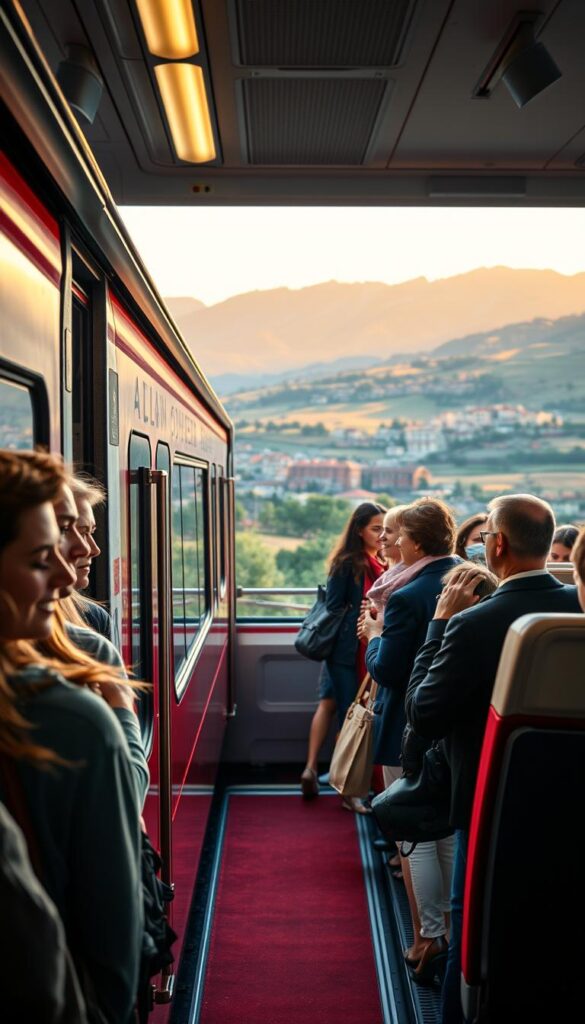
High-speed Frecciarossa trains connect major cities like Bologna to Lecce in under 6 hours – perfect for maximizing your day. Regional buses fill the gaps, reaching hilltop villages where stations feel like stepping into a postcard. Always validate tickets at yellow machines before boarding to avoid fines.
Renting a car unlocks hidden gems but comes with quirks. ZTL zones (limited traffic areas) in historic centers require careful navigation. For coastal stretches like Calabria’s cliffside roads, a road trip offers freedom. Yet trains win for stress-free city hops – no parking headaches or narrow medieval streets to navigate.
Three pro tips for stress-free travel:
- Avoid peak days (Friday evenings/Sunday afternoons) when locals travel
- Download Trenitalia’s app for real-time updates
- Use e-scooters in Florence or Rome to bypass crowded piazzas
With a mix of advance bookings and spontaneity, you’ll glide through your week like a seasoned traveler. Remember: Italy rewards those who plan just enough to leave room for serendipity.
🚆 Explore Italy by Train with Trip.com
Experience the charm of Italy’s countryside and lesser-known towns by train. Trip.com provides affordable train tickets, allowing you to traverse cities like Florence, Rimini, and Venice comfortably and efficiently. Embrace the scenic routes and immerse yourself in authentic Italian culture.
Savoring Authentic Italian Street Food and Local Cuisine
Your hands tell the story first – sticky from olive oil, dusted with flour from fresh focaccia. Italy’s street food culture thrives in alleyway kiosks and family-run friggitorie, where €3 buys more flavor than most sit-down meals. Forget tourist traps: this journey prioritizes hole-in-wall spots where nonnas argue over the perfect arancini filling.
Start your adventure in Genoa’s caruggi (narrow streets) with paper-wrapped farinata – a chickpea pancake crisped in wood-fired ovens. Head south to taste Sicily’s pane e panelle (chickpea fritters) at markets buzzing with fishmongers’ morning banter. Local wisdom? Follow office workers on lunch breaks – they know where the supplì oozes molten mozzarella.
Three unmissable bites:
- Bruschetta al pomodoro in Tuscan villages using oil pressed that week
- Liguria’s focaccia di Recco – paper-thin dough with creamy stracchino cheese
- Puglia’s orecchiette con cime di rapa served from street-side pasta carts
“Food here isn’t eaten – it’s lived,” says a third-generation Roman pizza al taglio maker. Small shops double as cultural hubs: butcheries aging prosciutto for 24 months, bakeries teaching kids to shape bread. Dedicated food stops in this plan let you taste Italy’s soul – one unexpected flavor at a time.
Let your nose guide you past lemon groves to cliffside trattorias with jaw-dropping Tyrrhenian Sea views. Every bite becomes a conversation starter, every market stroll a masterclass in regional pride. Ready to eat like someone’s Italian nonna just waved you into her kitchen?
Hidden Gems of Cinque Terre and the Ligurian Coast
While most travelers cluster around Monterosso’s main beach, smart explorers find empty cliffside trails near Vernazza. Arrive before 9 AM to watch fishermen unload their catch in Portofino’s sleepy harbor – your reward? A cornetto still warm from Forno Pasticceria Batti, its flaky layers dusted with local honey.
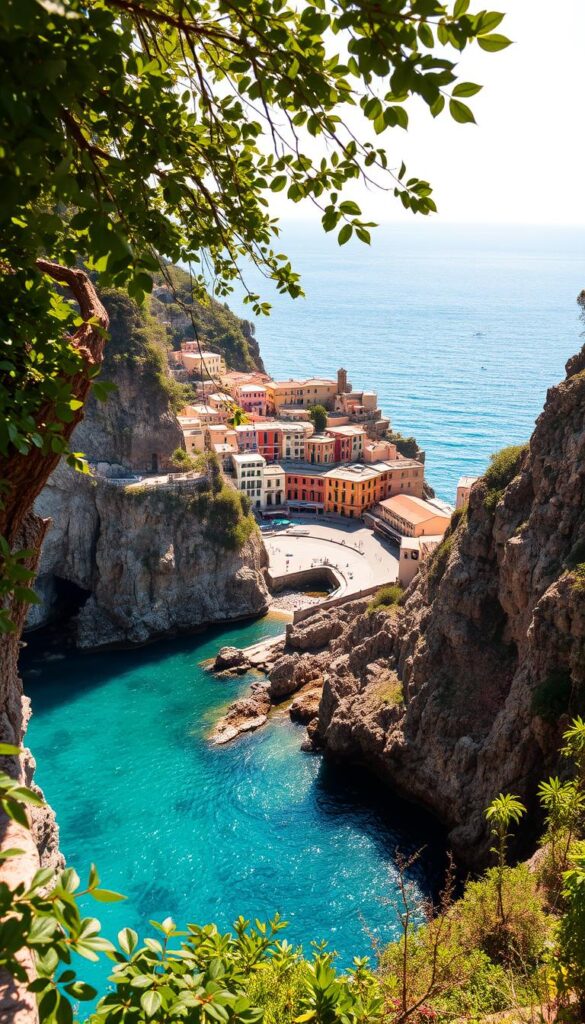
The train from La Spezia becomes your secret weapon. Skip the packed middle stops and ride to lesser-known Riomaggiore alleys where laundry flaps between peach-colored houses. Locals whisper about Sentiero del Vo – a coastal path offering Tyrrhenian Sea vistas without the Instagram crowds.
Three ways to dive deeper:
- Sip Sciacchetrà wine at family-run Cantina di Storie in Manarola’s hills
- Join nonnas rolling trofie pasta at a Levanto cooking collective
- Swim in Bonassola’s sheltered cove when day-trippers leave
“Our coast isn’t a museum – it’s a living kitchen,” says a third-generation focaccia baker in Recco. Follow the scent of rosemary to hole-in-wall friggitorie serving fried anchovies caught that morning. As sunlight dips, claim a bench overlooking Corniglia’s vineyard terraces – your view costs nothing but your presence.
This stretch of Italy begs you to wander. Let a stray cat lead you up stone staircases to hidden lemon groves. When asked, locals will highly recommend their cousin’s boat tour or aunt’s linen shop. Every quiet street holds stories waiting to replace your screensaver.
Tuscany Uncovered: Discovering Lucca, Florence, and Surrounding Villages
Tuscany’s rolling hills hide more than just vineyards – they cradle stories etched in medieval stone and sun-kissed olive groves. Start your itinerary in Lucca, where bike paths replace traffic jams and the Guinigi Tower sprouts oak trees from its rooftop. This city within Renaissance walls feels like a living museum, with quiet piazzas where locals debate the day’s pasta shape.
Renaissance Wonders & Secret Spots
Florence’s Uffizi Gallery dazzles, but savvy travelers save time for Oltrarno’s artisan workshops. Watch goldsmiths craft jewelry using techniques unchanged since the Medici era. Local guides often share hidden courtyards near Santa Croce – perfect spots to escape crowds while admiring Brunelleschi’s dome.
Venture into the region’s villages for true time-capsule moments. Montefioralle’s circular streets reveal family wineries pressing Sangiovese grapes by foot. In Anghiari, climb clock towers for views of terracotta rooftops that inspired Renaissance painters.
Local Culinary Delights
Tuscan food thrives in unmarked trattorias. Try tordelli lucchesi – meat-stuffed pasta served with ragu simmered for hours – at a family farm near Lucca. Pair it with a bold Vino Nobile from Montepulciano’s sun-drenched slopes.
Three ways to savor the wine country:
- Join grape harvests at organic vineyards in September
- Sample “under the table” olive oils at Chianti farmsteads
- Picnic with pecorino cheese and wild boar salami atop San Miniato’s hills
“Our way of cooking hasn’t changed in 500 years – why fix perfection?” laughs a third-generation butcher in Greve. As golden light bathes cypress-lined roads, you’ll understand why every day here feels like a love letter to slow living.
Experiencing Rome: The Eternal City Reimagined
Rome reveals its secrets to those who wander beyond the postcard views. While the Colosseum and Trevi Fountain dazzle, the eternal city truly comes alive in quiet cobblestone alleys where centuries-old bakeries share walls with modern art galleries. Start your day early at Campo de’ Fiori Market – watch vendors arrange blood oranges while discussing football with regulars.
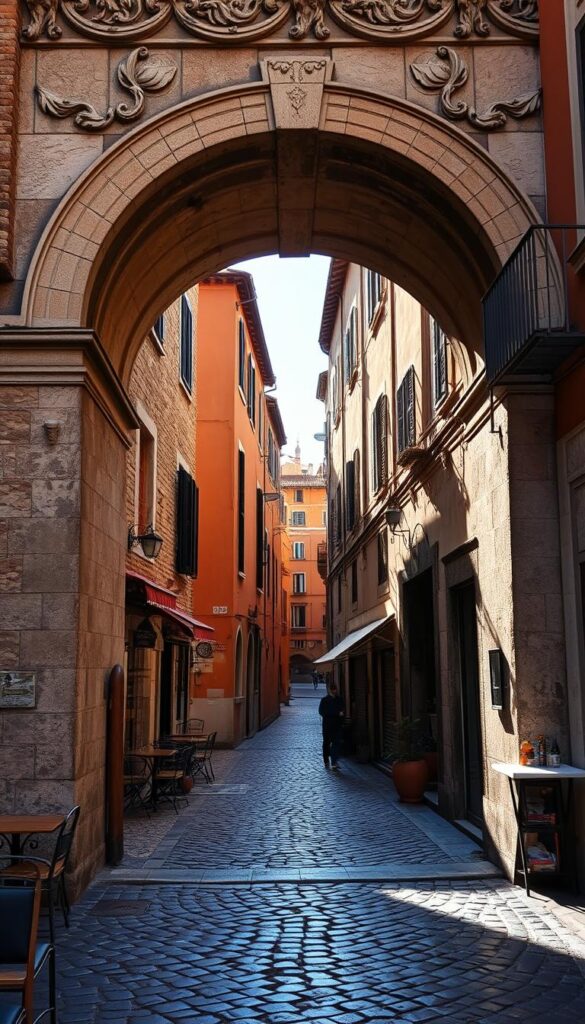
Offbeat Historical Landmarks
Skip the lines at the Pantheon and head to the Aventine Keyhole instead. Peek through this unassuming portal for a framed view of St. Peter’s Dome – a guide’s best-kept secret. The Baths of Caracalla often get overshadowed, but their towering ruins host summer operas under starry skies. Don’t miss Palazzo Doria Pamphilj’s private art collection, where Velázquez masterpieces hang in rooms untouched by museum crowds.
Unique Roman Meals and Treats
“We don’t eat to live – we live through eating,” says a third-generation pizzaiolo in Testaccio. Taste this philosophy in supplì (fried rice balls) at Antico Forno Roscioli, where molten mozzarella strings connect you to 19th-century street vendors. For dessert, join locals queuing at Regoli Pasticceria for maritozzo – whipped cream-stuffed buns that’ll make you rethink breakfast.
Three essential street food stops:
- Carciofi alla Giudia (Jewish-style artichokes) in the Jewish Quarter
- Porchetta sandwiches from Er Buchetto near Termini Station
- Gelato at Fatamorgana’s Monti location – try basil-honey-nuts flavor
Book tickets online for major sights to bypass queues, but leave evenings free for spontaneous discoveries. As twilight paints the Tiber gold, join Romans on their passeggiata along Via del Governo Vecchio. Here, the eternal city whispers stories through crumbling frescoes and espresso-scented breezes – proof that Rome’s greatest tour guide is curiosity itself.
A Journey Along the Amalfi Coast: Secluded Spots and Scenic Views
The Amalfi Coast whispers its secrets through waves lapping against hidden coves and lemon groves clinging to cliffs. While crowds pack Positano’s staircases by midday, early risers find empty beaches where sunlight dances on water as clear as Venetian glass. This stretch of coastline rewards those who venture beyond postcard-perfect towns.
Boat Trips and Coastal Hikes
Renting a small motorboat near Vietri sul Mare unlocks sea caves and fishing villages most itinerarys miss. “The best view of our coast? From right here,” says a local captain pointing to emerald waters beneath Faraglioni rocks. For hikers, the Path of the Gods trail dazzles with wildflower-lined cliffs – start before 8 AM to beat the heat and tour groups.
Three ways to savor the magic:
- Swim at Laurito Beach – accessible only by boat or steep stairs
- Stay in hillside B&Bs above Amalfi town for sunset panoramas
- Pack picnic lunches from family-run delis in Scala
Late afternoons transform the coast into a golden-hour dreamscape. Follow narrow lanes upward from Atrani to discover terraced gardens where elderly locals share stories over limoncello. These moments – far from crowded day tours – make the Amalfi Coast unforgettable. For deeper exploration, pair these tips with local insights on crafting your perfect Amalfi Coast.
Scalea and Calabria: A Serene Mediterranean Escape
In Scalea, the Mediterranean whispers through sun-bleached alleyways, inviting travelers to a slower, more authentic Italy. This coastal town in Calabria – one of the country’s least explored regions – trades crowds for cliffside vistas where wild rosemary scents the breeze. Stay in restored 19th-century villas with terra-cotta floors and wrought-iron balconies, where breakfast arrives with homemade bergamot jam.
Evenings here unfold like a watercolor painting. Watch the sun dip behind the Pollino Mountains from Spiaggia della Marinella, a pebble beach where views stretch uninterrupted to Stromboli’s distant silhouette. “Our secret? We’ve preserved the rhythm of la dolce vita,” shares a third-generation hotelier at Palazzo Chidro, a converted noble residence.
Three ways to savor this trip’s serenity:
- Swim before 10 AM when beaches feel private
- Join fishermen mending nets at Scalea’s quiet harbor
- Sip Calabrian Greco wine at cliffside bars as lights twinkle in nearby cities
This stretch of your trip offers respite from busier coastal routes. Let afternoons dissolve into long lunches of nduja-spiced pasta under pergolas draped with bougainvillea. As the region’s starry skies emerge, you’ll understand why Calabria remains Italy’s best-kept seaside secret.
Transitioning to Sicily: Ferry Crossings and Arrival Tips
Crossing into Sicily feels like stepping through a portal to Italy’s sun-drenched soul. The 20-minute ferry ride from Villa San Giovanni to Messina costs €15-25 per car – book directly through operators like Caronte & Tourist to avoid inflated third-party prices. Arrive 45 minutes early to secure parking spots on board, where panoramic decks offer your first glimpse of Sicilian coastline.
Watch for “supplemento” fees added to tickets at boarding – always request itemized receipts. Scams here are rare but savvy travelers double-check charges against official site prices. The crossing itself buzzes with energy: vendors sell arancini as Mount Etna’s silhouette emerges on the horizon.
Three keys to smooth sailing:
- Use regional trains from Messina for stress-free day trips to Taormina
- Download ferry apps like Traghettiamo for real-time updates
- Keep euros handy for taxi drivers who “forget” card machines
“Sicily rewards those who come prepared,” advises a Catania-based tour operator. Store your rental car’s insurance docs securely – narrow coastal roads demand extra caution. With smart planning, your transition from mainland to island becomes an adventure starter rather than a hassle.
Exploring South Sicily: Ancient Temples and Rugged Coasts
Standing where ancient Greeks once worshipped, the Valley of the Temples offers more than ruins – it’s a conversation across millennia. Golden-hour light bathes Doric columns that have outlasted empires, while the Mediterranean shimmers like liquid mercury in the distance.
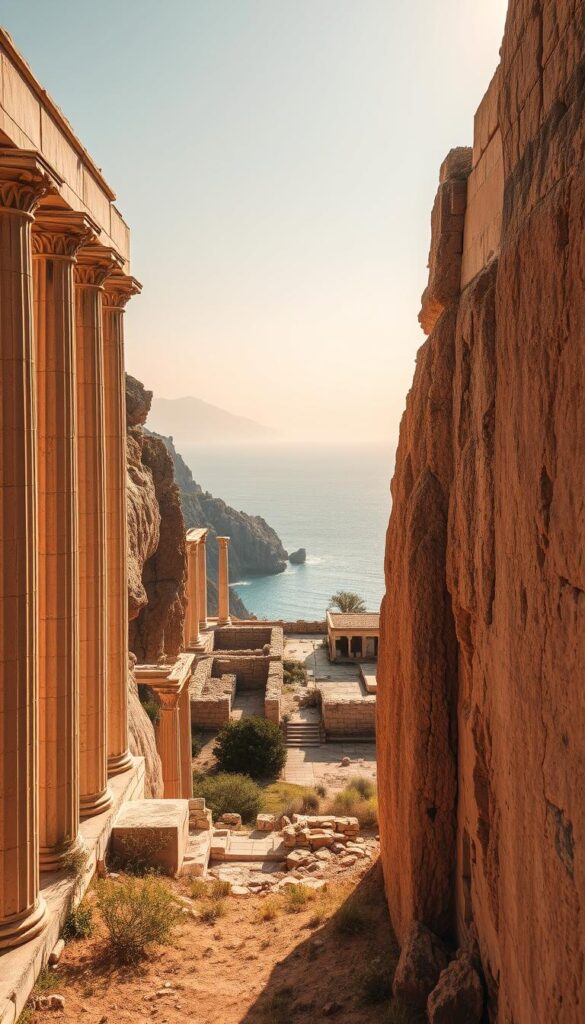
Time Travel Among Olive Groves
Entry tickets start at €13.50 (discounts for EU visitors under 25), granting access to eight temples and almond groves blooming in spring. Arrive at 8:30 AM to walk the Sacred Way alone, when morning mist clings to the Temple of Concordia’s steps. “This isn’t just archaeology – it’s our origin story,” shares a local guide leading twilight tours.
The site feels like an open-air museum, with informational plaques detailing how 5th-century BC engineers aligned structures with celestial events. Don’t miss the Garden of Kolymbetra – an oasis of citrus trees and natural springs tucked between two temple complexes.
Three tips for your day trip:
- Wear sturdy shoes for rocky paths near the Temple of Juno
- Combine with a swim at nearby Scala dei Turchi’s white cliffs
- Book evening visits in summer for cooler temps and dramatic lighting
As salty breezes carry the scent of wild capers, you’ll understand why these sights captivated poets and conquerors. Let the Ionian Sea’s watercolors at sunset be your final postcard from Sicily’s storied shores.
Northern Sicily Delights: From Erice to Palermo and Taormina
Northern Sicily unfolds like a layered history book where Arab-Norman domes meet Baroque balconies. Here, you’ll discover villages clinging to cliffsides and a city buzzing with markets that smell of fried panelle and jasmine. Start in Erice – a medieval hilltop gem where cobblestone alleys twist like a labyrinth designed by giants.
Charming Villages and Cultural Wonders
Erice’s stone walls reveal panoramic views stretching to the Egadi Islands. “Our castle isn’t leaning – it’s dancing with time,” jokes a local guide while pointing to 12th-century battlements. Downhill, Trapani’s salt flats glow pink at dusk – perfect for a leisurely day trip.
Palermo thrills with contradictions. Hunt for hidden courtyards in the Kalsa district, where laundry dries beside 17th-century palazzos. Don’t miss the museum-quality street art near Ballarò Market. For contrast, Taormina’s Greek Theatre offers front-row seats to Mount Etna’s smoky performances.
- Sip almond granita at Erice’s Pasticceria Maria Grammatico
- Join sunset tours of Palermo’s UNESCO-listed Norman Palace
- Walk Taormina’s Corso Umberto when shops glow like gold-leafed treasure boxes
These destinations feel worlds apart from crowded tourist hubs. Spend a week here, and you’ll understand why Sicilians measure time in espresso sips and citrus harvests. Let slow travel reveal the island’s soul – one sun-warmed stone at a time.
Insider Tips: Balancing Public Transport and Self-Drive Options
Your transportation choices in Italy shape more than just routes—they define how you experience la dolce vita. Trains shine for city-to-city hops like Milan to Bologna, where high-speed rails save time and bypass traffic. But when exploring Puglia’s olive groves or Sicily’s coastal backroads, a rental car becomes your golden ticket to freedom.
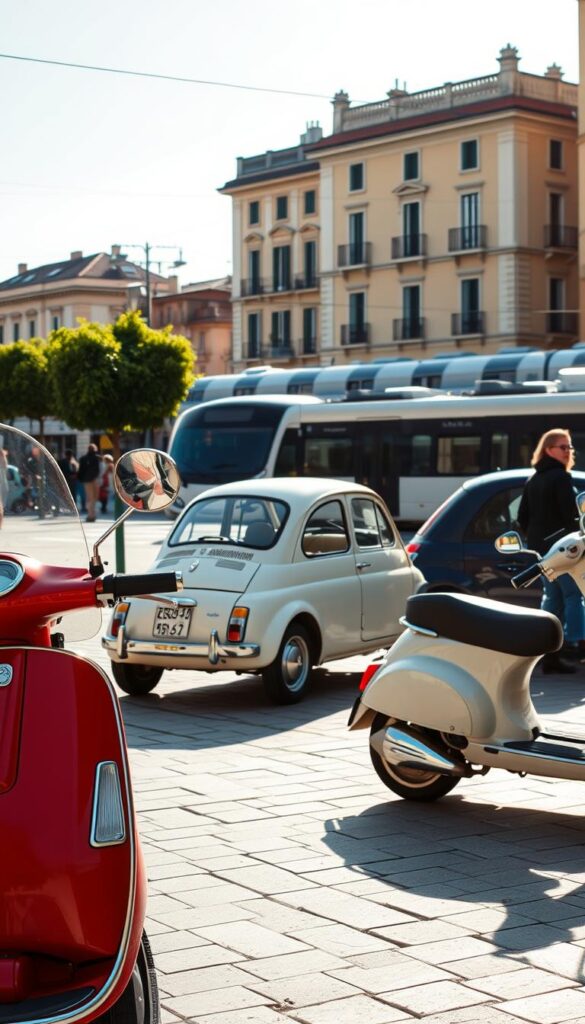
Pros of trains? No parking nightmares or ZTL zone fines. Cons? Limited access to villages where buses run twice daily. “Use regional trains for day trips,” advises a Rome-based guide, “but rent wheels for areas where Google Maps shows squiggly lines.”
Three ways to blend both:
- Book trains between major hubs (Florence-Rome-Naples)
- Rent cars in regions like Basilicata for 2-3 day explorations
- Use bus apps like Moovit for last-mile connections
Always validate paper tickets at station machines—€50 fines hurt. For drivers, screenshot offline maps before mountain areas. Flexibility is key: swap a planned day in Genoa for an extra time in Cinque Terre if weather favors hiking.
Guided tours offer shortcuts to local wisdom. Join a half-day guided tour in Palermo’s markets, then venture solo using your new street food map. This way, you gain confidence to explore independently.
Balance saves time and stress. Let trains handle long stretches while cars unlock hidden trip highlights. With smart mixing, you’ll feel like a local navigating Italy’s rhythm—not just a visitor checking schedules.
Accommodations and Authentic Local Experiences Off the Beaten Path
Your morning begins with the scent of freshly baked cornetti drifting through shuttered windows – not from a chain hotel, but a 17th-century palazzo where the owner shares stories over breakfast. Choosing where to stay transforms your trip from ordinary to unforgettable, especially when you feel like part of the neighborhood.
Family-run places offer more than beds – they’re gateways to hidden villages. In Scalea, restored seaside villas feature terraces overlooking the Tyrrhenian Sea. Florence’s Oltrarno district hides B&Bs where artisans demonstrate leatherworking techniques passed through generations.
Three ways to deepen cultural connections:
- Book agriturismos where owners cook meals with homegrown ingredients
- Choose historic residences like Palazzo Chidro for sunset views
- Visit neighborhood shops recommended by your hosts
“Guests become friends here,” says a third-generation innkeeper near Lecce. Her tip? Wander side streets after dinner when bakeries prep tomorrow’s bread. You’ll discover food spots untouched by tourism – like Puglia’s fornelli pronti serving pasta from open windows.
🏨 Stay in Italy’s Hidden Treasures
Find accommodations that reflect the unique character of Italy’s off-the-beaten-path destinations. Trip.com offers a curated selection of hotels and guesthouses, ensuring you have a cozy place to rest after each day’s adventure. From rustic countryside inns to charming coastal lodgings, discover stays that enhance your travel experience.
We highly recommend spending time researching stays through local-led experiences. These gems rarely appear on booking sites but reward travelers with citrus gardens, cooking classes, and insider maps. When your accommodation feels like a friend’s home rather than a hotel, Italy’s magic truly unfolds.
Conclusion
Your adventure through Italy’s hidden corners leaves more than memories—it rewires how you travel. From coastal trails in Cinque Terre to Sicily’s ancient ruins, each discovery proves that magic thrives beyond crowded hotspots. You’ve learned to navigate regional trains like a pro and savor meals where locals debate olive oil brands.
This itinerary balances structure with spontaneity. Whether you chose a guided tour of Palermo’s markets or a solo day trip through Tuscan vineyards, those moments became your story. Remember how sunset in Scalea painted the sea gold, or the thrill of finding empty Baroque courtyards?
Use these tips as your compass—not a rigid map. Book that agriturismo overlooking olive groves. Let a slow train ride through Le Marche inspire detours. Italy rewards those who embrace its rhythm.
Though this article ends here, your journey doesn’t. Keep it handy when planning—whether revisiting Puglia’s whitewashed city quarters or exploring new regions. Now go: your next view of the Mediterranean awaits, espresso in hand and curiosity leading the way.
